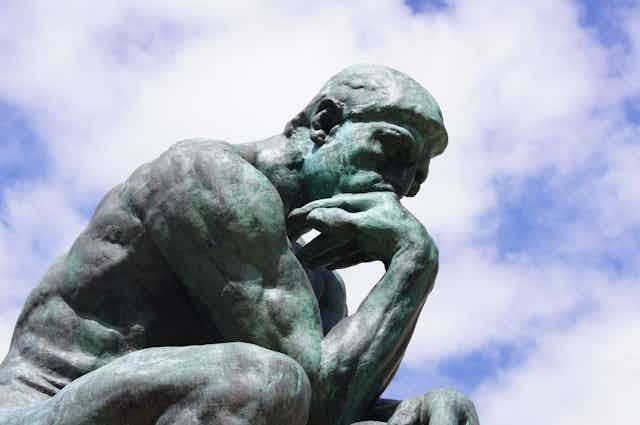We like to think that we reach conclusions by reviewing facts, weighing evidence and analysing arguments. But this is not how humans usually operate, particularly when decisions are important or need to be made quickly.
What we usually do is arrive at a conclusion independently of conscious reasoning and then, and only if required, search for reasons as to why we might be right.
The first process, drawing a conclusion from evidence or facts, is called inferring; the second process, searching for reasons as to why we might believe something to be true, is called rationalising.
Rationalise vs infer
That we rationalise more than we infer seems counter-intuitive, or at least uncomfortable, to a species that prides itself on its ability to reason, but it is borne out by the work of many researchers, including the US psychologist and Nobel Laureate Daniel Kahneman (most recently in his book Thinking Fast and Slow).
We tend to prefer conclusions that fit our existing world-view, and that don’t require us to change a pleasant and familiar narrative. We are also more inclined to accept these conclusions, intuitively leaping to them when they are presented, and to offer resistance to conclusions that require us to change or seriously examine existing beliefs.
There are many ways in which our brains help us to do this.
Consider global warming
Is global warming too difficult to understand? Your brain makes a substitution for you: what do you think of environmentalists? It then transfers that (often emotional) impression, positive or negative, to the issue of global warming and presents a conclusion to you in sync with your existing views.
Your brain also helps to make sense of situations in which it has minimal data to work with by creating associations between pieces of information.
If we hear the words “refugee” and “welfare” together, we cannot help but weave a narrative that makes some sort of coherent story (what Kahneman calls associative coherence). The more we hear this, the more familiar and ingrained the narrative. Indeed, the process of creating a coherent narrative has been shown to be more convincing to people than facts, even when the facts behind the narrative are shown to be wrong (understood as the perseverance of social theories and involved in the Backfire Effect).
Now, if you are a politician or a political advisor, knowing this sort of thing can give you a powerful tool. It is far more effective to create, modify or reinforce particular narratives that fit particular world-views, and then give people reasons as to why they may be true, than it is to provide evidence and ask people to come to their own conclusions.
It is easier to help people rationalise than it is to ask them to infer. More plainly, it is easier to lay down a path for people to follow than it is to allow them to find their own. Happily for politicians, this is what our brains like doing.
How politicians frame issues
This can be done in two steps. The first is to frame an issue in a way that reinforces or modifies a particular perspective. The cognitive scientist George Lakoff highlighted the use of the phrase “tax relief” by the American political right in the 1990s.
Consider how this positions any debate around taxation levels. Rather than taxes being a “community contribution” the word “relief” suggests a burden that should be lifted, an unfair load that we carry, perhaps beyond our ability to bear.
The secret, and success, of this campaign was to get both the opposing parties and the media to use this language, hence immediately biasing any discussion.
Interestingly, it was also an initiative of the American Republican party to rephrase the issue of “global warming” into one of “climate change”, which seemed more benign at the time.
Immigration becomes security
In recent years we have seen immigration as an issue disappear, it is now framed almost exclusively as an issue of “national security”. All parties and the media now talk about it in this language.
Once the issue is appropriately framed, substitution and associations can be made for us. Talk of national security allows us to talk about borders, which may be porous, or even crumbling. This evokes emotional reactions that can be suitably manipulated.
Budgets can be “in crisis” or in “emergency” conditions, suggesting the need for urgent intervention, or rescue missions. Once such positions are established, all that is needed are some reasons to believe them.
The great thing about rationalisation is that we get to select the reasons we want – that is, those that will support our existing conclusions. Our confirmation bias, a tendency to notice more easily those reasons or examples that confirm our existing ideas, selects just those reasons that suit our purpose. The job of the politician, of course, is to provide them.
Kahneman notes that the more familiar a statement or image, the more it is accepted. It is the reason that messages are repeated ad nauseam, and themes are paraphrased and recycled in every media appearance. Pretty soon, they seem like our own.
How to think differently
So what does this mean for a democracy in which citizens need to be independent thinkers and autonomous actors? Well, it shows that the onus is not just on politicians to change their behaviour (after all, one can hardly blame them for doing what works), but also on us to continually question our own positions and judgements, to test ourselves by examining our beliefs and recognising rationalisation when we engage in it.
More than this, it means public debate, through the media in particular, needs to challenge preconceptions and resist the trend to simple assertion. We are what we are, but that doesn’t mean we can’t work better with it.

